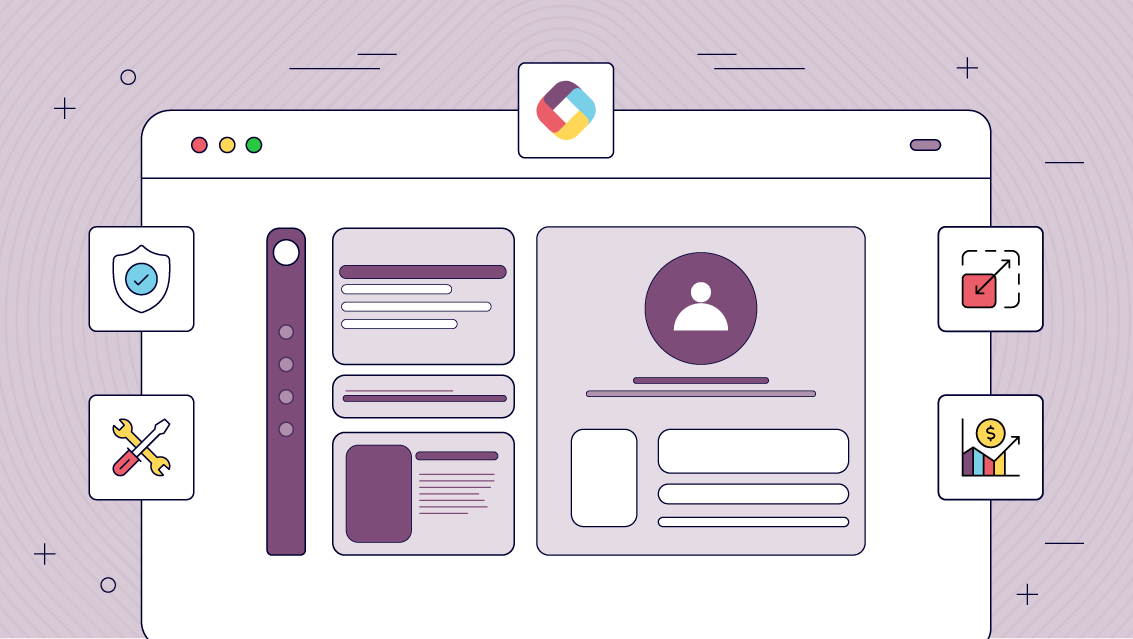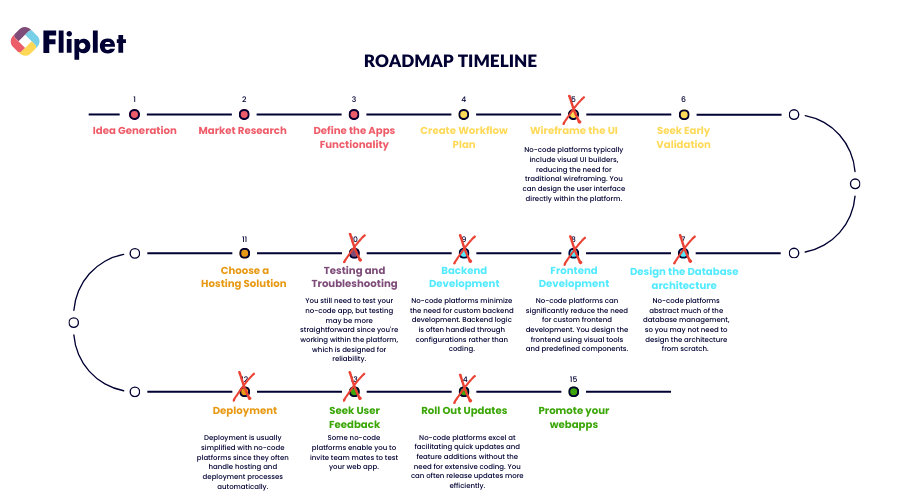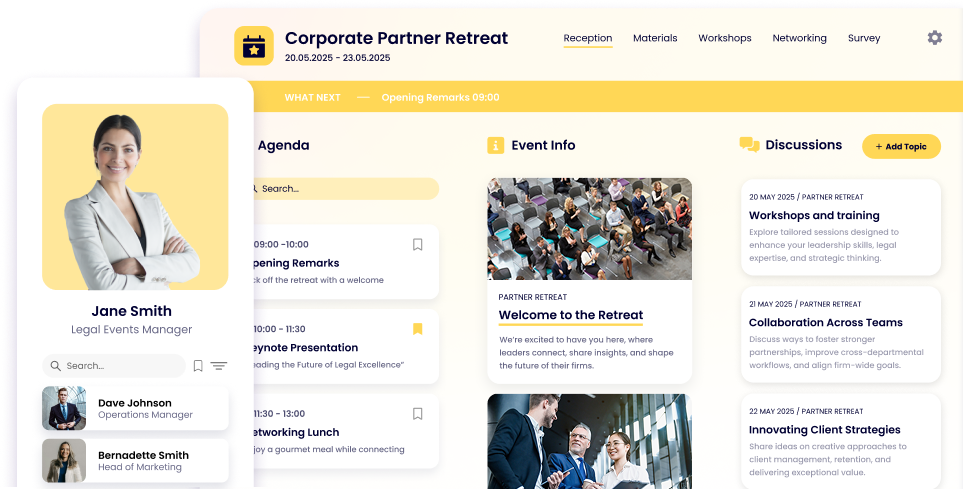6 Web Application Development Platforms to Build a Free Web App

Niamh Conneely | Marketing Executive

Web application development platforms have emerged as crucial tools for enhancing efficiency, connecting with customers, and driving growth. These platforms empower organizations to deliver interactive services, streamline processes, and engage with a global audience. However, selecting the right web application development platform can pose a challenge.
There are multiple ways to develop web applications, catering to a diverse range of needs and expertise. Developers can choose between traditional coding methods and the emerging trend of no-code solutions. Traditional coding offers a high degree of customization and control, allowing developers to craft web apps tailored to specific requirements. On the other hand, no-code platforms make web app development more accessible, enabling individuals with diverse skill sets, including citizen developers, to create powerful applications without extensive coding knowledge.
This blog will serve as your guide of web app development, exploring both traditional coding platforms and the emerging trend of no-code solutions. We’ll navigate the crucial decision of choosing the ideal web application development platform, taking into account factors such as ease of use, scalability, cost-effectiveness, security, and support.
The Evolution of Web App Development

In this section, we explore the evolution of web application development. But before we look into the historical journey, let’s first clarify what a web application is and distinguish it from a website.
What is a Web Application?
A web application, often referred to as a web app, is a dynamic software application that operates through web browsers, offering users interactive and personalized experiences. Unlike static websites, web applications are designed to perform specific functions and engage users by responding to their input and delivering real-time content.
How is a Web App Different from a Website?

While both web apps and websites share similarities in their online presence and accessibility, they differ fundamentally in their purposes and capabilities. Websites are primarily informational and provide content that users can read, view, or interact with in a limited way, such as clicking links to access more pages.
In contrast, web applications are interactive tools that allow users to actively engage, input data, and receive dynamic outputs. They serve specific functions, such as online banking, social media platforms, or e-commerce portals, where users perform actions like transactions, communication, or data manipulation within the application.
Check out this blog on Social Mobility Business Partnership’s Journey with Web and Mobile Apps.
The Evolution of Web App Development

The development of web applications has transformed over the years, driven by advancements in technology and changing user expectations. From the early days of static web pages to the dynamic, data-driven web applications of today, the journey has been marked by innovations in programming languages, frameworks, and development methodologies.
Want to know how to start building your web app? Check out this guide on how to create a web app in 15 steps.
Transition from Traditional Coding to No-Code Platforms
One of the most significant shifts in web app development has been the transition from traditional coding approaches to the emergence of no-code and low-code platforms. These platforms empower individuals with little to no-coding experience to create functional web applications using intuitive visual interfaces, pre-built templates, and drag-and-drop components. No-code/low-code web application development platforms have made it more accessible to a broader audience to access and accelerate innovation.
Build your web app for free with Fliplet, a no-code/low-code web application development platform.
The Democratization of Web App Development with Citizen Developers
The move towards no-code/low-code web applications platforms has made it easier for people without coding skills to create web apps. These “citizen developers” know a lot about their business and what they need from an app. They can use easy-to-use platforms to make apps that fit their needs, helping to bring new ideas and better teamwork into companies.
Criteria for Choosing a Web App Development Platform
Choosing the right web application development platform is a decision that can impact the success of your project. With a selection of options available, it’s crucial to focus on a set of key criteria that align with your organizational needs. Here are some vital considerations to guide your selection process:
- Ease of Use: Choose a platform that has a user-friendly interface. This is especially crucial if “citizen developers” will be using it. A straightforward, intuitive design can speed up the development process and make it accessible to more team members.
- Scalability: Your organization will grow, and so will your needs. A scalable platform can easily adapt to increased loads and complexities, preventing the need for a system overhaul in the future.
- Cost-Effectiveness: While initial costs are a consideration, also look at long-term value. Consider both the upfront investment and the ongoing costs for maintenance and updates. However, these platforms we will be showcasing in this blog all allow you to build a web app for free.
- Security: Make sure the platform you choose complies with industry security standards and offers robust features like encryption and multi-factor authentication. Some security standards you should look out for are ISO27001 certified. ISO 27001-certified organizations can show customers, partners and shareholders that they have taken steps to protect data in the event of a breach. This can help minimize the financial and reputational damage caused by a data breach.
- Support: A strong community and readily available support can make problem-solving quicker. Check if the platform has a helpful online community, documentation, and customer support services to assist you when challenges arise. For more information take a look at the 16 top features of a successful app.
Build your web app for free with Fliplet, a no-code/low-code web application development platform.
Benefits of Web App Development
Web app development holds transformative potential for businesses, enabling them to better engage with customers, streamline operations, and achieve cost efficiency. With an array of benefits to consider, it’s an avenue worth exploring for most organizations.
- Increased Customer Engagement: Web apps provide a platform for interactive features and personalized experiences that boost customer satisfaction and engagement.
- Streamlined Internal Processes: Simplify workflow and communications, cutting down on time and resources spent on manual tasks.
- Cost Savings: Reduce operational and maintenance costs by moving various business processes online.
- Flexibility and Accessibility: Access your business information anytime, anywhere, offering increased flexibility for your team.
- Enhanced Security: With proper measures, web apps can provide a secure environment to protect company data.
- Scalability: Easily scale your operations up or down based on your business needs without significant changes to the web app.
- Customization: Tailor your web app to meet the specific requirements and workflows of your organization.
- Global Reach: Extend your business reach with a web app that’s accessible to users worldwide.
Examples of Traditional Coding Web Application Development Platforms
Choosing a traditional coding web application development platform can be a daunting task. Each platform comes with its own set of unique features, benefits, and drawbacks. If you have coding skills or a dedicated development team, traditional coding allows you to harness the full potential of customization and control. Understanding these platforms and their nuances can help you make a well-informed decision that aligns with your specific needs and objectives.
1 Ruby on Rails

Ruby on Rails is an open-source application framework based on the Ruby programming language. It’s known for its agility and productivity, making it a popular choice for Agile development. Notable applications include GitHub, Airbnb, and Hulu. Ideal for startups and dynamic small to large businesses.
Pros
- Speed of Development
- Built-in security features
- Extensive ecosystem
Cons
- Lack of flexibility
- Insufficient documentation
- Slower boot speed
Unique Benefit
Notable for its developer-friendly environment and quick time-to-market, Ruby on Rails stands out for its predictability and ease of code modification.
2 AngularJS

AngularJS is a JavaScript-based open-source framework released in 2009 and revamped in 2016. It’s often used for mobile e-commerce, video streaming, and single web-page applications. Companies like Google and Netflix have used AngularJS.
Pros
- Easy to test
- Extensible
- Fast load times
- Google-supported
Cons
- Security concerns
- Complexity
- Poor rendering on old devices
- Learning curve with MVC architecture
Unique Benefit
AngularJS is especially good for building single-page applications with an MVC architectural pattern, offering ease of testing and an extensible platform.
3 ASP.NET

ASP.NET is a framework released by Microsoft in 2002. It’s widely used for creating rich and dynamic web pages and portals, both for desktop and mobile app development. It is scalable and dynamic.
Pros
- Easy to update and deploy
- Cross-platform development
- Impressive language support
Cons
- Expensive
- Lacking documentation
- Subpar security features
Unique Benefit
ASP.NET is renowned for its suitability in enterprise-level applications, offering easy updates and deployment along with a range of language support.
Traditional Coding Web Application Platforms like Ruby on Rails, AngularJS, and ASP.NET certainly have their merits. They offer extensive customization options, robustness, and are backed by a community of expert developers.
Examples of No-Code Web Application Platforms
We’d recommend considering no-code web application platforms for your business needs, especially if you have no coding knowledge. These platforms are designed to be user-friendly, eliminating the need for specialized coding skills. This allows team members across departments to contribute, fostering collaboration and innovation.
Moreover, they speed up the development timeline and can lead to substantial cost savings. The ease of use and financial benefits make no-code platforms a great option for many businesses. Let’s look at some of the most popular no-code web application development platforms.
4 Fliplet

Why Fliplet? Fliplet offers both no-code and low-code options and allows you to build web apps for free. It serves various use-cases with its pre-built solutions, including events, community, learning, emergency management, task management, and innovation management. It also boasts enterprise-grade security.
Pros
- Free to use
- Trusted by over 100 organizations
- Globally awarded
- Good customization features such as brand your app
- Easy to use
- Intuitive drag and drop interface
- Pre-built solutions saving you time and money
- Great support team
- Easy to scale your web app as your organization grows
Cons
Although you can customize each solution to make it your own, if you want to have a unique solution you may need to add your own code, or get the Fliplet support team to help you
Unique Benefit
One standout feature is its cross-platform functionality; you can create one app and publish it across mobile, tablet, and desktop. Fliplet also easily integrates with existing systems and offers analytics. Fliplet has also incorporated AI features into their solution to ensure organizations stay ahead of their competitors.
Build your web app for free with Fliplet.
5 WordPress

WordPress is primarily known as a content management system (CMS) for websites and blogs, but it’s also a versatile platform for developing web applications. It’s widely used for creating various web apps, including e-commerce stores, forums, social networks, membership sites, and more.
Pros
- User-Friendly
- Customization
- SEO-Friendly
- Cost-Effective
- Scalability
Cons
- Heavily customized or plugin-heavy WordPress sites may experience performance issues if not optimized correctly.
- While beginner-friendly, mastering advanced customization may require a learning curve.
- Regular updates and maintenance are essential to keep a WordPress site secure and functional.
Unique Benefit
WordPress stands out for its vast library of plugins and themes, enabling people to quickly build and customize web applications with ease.
6 Shopify

Shopify is a no-code platform primarily focused on e-commerce solutions. It allows anyone to set up an online store and sell their products.
Pros
- User-friendly interface
- Scalable
- Robust e-commerce features
Cons
- Limited customization
- Transaction fees apply unless using Shopify Payments
Unique Benefit
Shopify offers a complete e-commerce solution, from inventory management to payment gateways, making it a one-stop shop for online business needs.
Discover How to Build a Custom App Without Any Coding (6 Steps)
The Fliplet Advantage

Fliplet stands out as a powerful web application development platform that offers the best of both worlds: no-code and low-code solutions. Whether you’re a seasoned developer or just starting in the world of web app creation, Fliplet has got you covered – and here’s the exciting part – you can build your web app for free, catering to up to 50 users! Yes, you read that right!
With Fliplet’s user-friendly interface and extensive capabilities, you can bring your web app ideas to life without breaking the bank. Plus, Fliplet’s impressive track record includes trust from over 100 organizations and recognition with numerous global awards. When it comes to web app development, Fliplet is what you need to get started.
What Web Applications can you build with Fliplet?
Fliplet has a large selection of pre-built app solutions that you can fully customize to suit your needs, these include:
- Learning (Want to start building your learning app? Read this blog to see how you can build one on a budget)
- Directory (Check out 15 HR apps that will change the way you work)
- Marketing
- Innovation/idea management
- Approval workflow
- Portal app
- Sales Enablement
- Communications (Take a look at this blog where we compared the top 10 community apps to engage and monetize your community or you can check out the 15 best team communication apps of 2023)
- Data capture
- Emergency Management (Take a look at the 5 steps to take to prepare for a dawn raid)
- Events (To compare our Event solution to other solutions read the 25 best mobile event apps you need in 2023)
- Ecommerce and ordering
- Multilingual
- Remote and office management
- Task management
- Reporting App
- Project Management
- Blank solution to build from scratch
Unique Features and Benefits
Fliplet offers easy, ready-to-use solutions to save you time. Every solution comes packed with advanced features to accelerate your app creation process. Plus, with full customization capabilities, you can tailor each solution to resonate with your brand. Efficient, effective, and entirely yours.
Fliplet clients have created a diverse range of apps, from internal to client-facing solutions. Each solution comes with its own unique features tailored for its purpose, but all of them have standard Fliplet features that make it easy to create and personalize such as:
- Brand your app
- Customize with drag and drop
- Upload your own content
- Use on any device
- Integrate easily
- Preview and test
- Add your own code if you want
- Enterprise security
- Publish on any device
- AI features
- Multilingual apps
For a full list of features, you can check out their features page.
Whether you are looking to increase employee engagement, streamline internal processes, or improve client relationships, Fliplet provides a flexible, secure, and intelligent foundation upon which to build.
Case Studies
Fliplet isn’t just another platform; it’s a platform that has proven success. Various organizations have utilized Fliplet to transform their operations, achieve higher levels of engagement, and streamline processes.
Case studies provide real-world evidence of how Fliplet can be an asset to any business, large or small, take a look at some of the case studies Fliplet has:
Fliplet has helped put Gowling WLG at the forefront of digital innovation, by allowing them to transition quickly from an idea to a fully-functioning app in record time, from event apps to learning apps.
Discover how Fliplet has brought about a paradigm shift in Gateley’s problem-solving approach, saving them significant time and costs that are typically involved in traditional app development.
Encountering difficulties with their self-built mobile app’s upkeep, Ward and Smith leveraged Fliplet for easier, quicker app creation, relieving the stress and pressure on the IT team.
Social Mobility Business Partnership
Discover how technology has transformed and streamlined operations at SMBP.
An innovation challenge app that has collected innovative staff ideas, helped build a community, driven innovation and improved collaboration.
Fully customized event app that transformed the conference experience.
Comparative Analysis: Why Fliplet is the Ultimate Choice
When it comes to choosing the ideal web application development platform, making an informed decision is paramount. Let’s delve into why Fliplet emerges as the ultimate choice for your web app development needs.
Feature-by-Feature Comparison
Fliplet offers feature-rich web apps whether you’re comparing customization capabilities, user-friendliness, or scalability, Fliplet consistently ranks among the top contenders. The user-friendly interface caters to both seasoned coders and newcomers, providing the perfect place to transform web app concepts into reality. This streamlined approach sets Fliplet apart, providing you with the best tools to achieve your web app goals.
Cost-Benefit Analysis
One of Fliplet’s standout features is the opportunity to build a web app for free. Yes, you heard that right. Fliplet allows you to create and develop your web app at no cost, making it accessible to a broad range of users and organizations. This not only simplifies your budgeting but also opens doors to creativity and innovation without the financial burden. With Fliplet, your web app dreams can become a reality without breaking the bank.
Security Features
Security is paramount in the digital landscape, especially when dealing with web applications. Fliplet doesn’t compromise here either. It offers robust enterprise-level security features that ensure your web app and data remain safe and sound. With Fliplet, you can rest easy knowing that your creation is protected by top-tier security protocols, safeguarding your users and your business.
In summary, when you compare features, evaluate costs, and prioritize security, Fliplet emerges as the ultimate choice for web application development platforms. Its feature-rich environment, free web app development opportunities, and enterprise-level security make it a standout option for businesses and individuals alike.
How does the choice of a web app development platform affect your business ROI?
The choice of a web app development platform can significantly impact your business ROI. With numerous web application development platforms available, selecting the one that best aligns with your coding knowledge and business goals is crucial. Traditional coding platforms offer a high degree of customization but may require advanced coding skills, potentially leading to higher development costs and longer timelines.
On the other hand, no-code platforms democratize web app development, allowing individuals with varying skill sets to contribute, which can reduce costs and accelerate development. Making an informed choice based on your coding knowledge and specific needs can ultimately maximize your business’s return on investment by streamlining development processes, increasing efficiency, and ensuring that your web app meets your objectives effectively.
The choice of a web app development platform can significantly impact your business’s Return on Investment (ROI) in various ways. Here’s how:
- Speed of Development: Platforms with pre-built templates and user-friendly interfaces enable quicker app development, reducing time-to-market. The faster you can roll out an application, the quicker you can start seeing financial returns and user engagement.
- Cost-Efficiency: Traditional coding platforms like Ruby on Rails or ASP.NET may require a dedicated development team, increasing costs. On the other hand, no-code platforms like Fliplet can be more cost-effective by eliminating or reducing the need for skilled developers.
- Customization and Scalability: Platforms like Node.js provide high levels of customization and scalability but might entail a steep learning curve and higher initial costs. This can be balanced out if your business model relies on an application that needs to scale rapidly and customize deeply, yielding higher ROI in the long run.
- Security: A platform with robust security features minimizes the risk of data breaches and the associated legal and reputational costs. Security compliance is not just about avoiding fines; it’s also about building customer trust, which directly translates into ROI.
- Integration Capabilities: Platforms that easily integrate with existing systems or third-party services (like Zapier or Shopify) can expand your business capabilities without significant investment, thus improving ROI.
- User Experience: The smoother the user experience, the higher the customer retention and engagement rates. A well-designed app on a competent platform can drive customer loyalty and, in turn, ROI.
- Future-proofing: Technologies are constantly evolving. Choosing a platform that is committed to updates and new feature rollouts can save you the cost of migrating to a new system later, protecting your ROI in the longer term.
- Maintenance: Some platforms require constant updates and maintenance, which can be a drain on resources and time. Lower maintenance needs can translate to better ROI.
Now you have your web app you can look into creating a mobile app. Find out How to Turn Your Web App to Mobile App.
The right platform can set you on a trajectory for high ROI by balancing initial costs, ongoing maintenance, and scalability while maximizing user engagement and security. So, when you’re in the process of choosing a web application development platform, these are the ROI-related factors you should be considering.
Are no-code platforms the future of web app development?

The tools organizations use to engage with their audience must also advance. One of the most transformative trends in technology right now is the rise of no-code platforms for web app development.
No-code platforms are a game-changer in web app development, significantly accelerating the entire process. By providing intuitive, visual interfaces and pre-built components, these platforms empower users to design, build, and deploy web apps with minimal coding or technical expertise. This speed-up is especially evident in tasks like UI design, database setup, and logic configuration, which traditionally consume considerable time and resources. Here is how no-code platforms like Fliplet, can speed up the development of your web app:

No-code platforms are more than just a convenient tool; they are shaping the very future of how businesses will operate in a digital-first world. Let’s explore three reasons why no-code platforms are becoming the dominant approach in web app development.
Accessibility for All
No-code platforms offer a way for people with limited or no coding skills to engage in web app development. As businesses continue to prioritize digital initiatives, the capability for non-specialist staff to develop apps becomes increasingly valuable. This broadens the pool of contributors, thereby accelerating innovation within organizations.
Adaptable
In a fast-changing business environment, companies need to be agile and responsive. No-code platforms facilitate rapid development and modifications, enabling businesses to quickly test new ideas, collect user feedback, and refine their offerings. This adaptability is vital for staying ahead in the market, meeting consumer expectations, and even foreseeing upcoming trends.
Economical Efficiency
Traditional web app development can be expensive, both in terms of time and skilled labor. No-code platforms significantly reduce these costs by enabling quicker development cycles and requiring fewer specialized personnel. This cost efficiency allows companies to divert saved resources to other strategic areas, thereby improving their competitive edge and profitability.
Check out our blog on Why use a pre-built app builder?
Conclusion
In a landscape filled with a diverse range of web app development platforms, each comes with its own set of unique benefits geared toward different needs. Whether it’s the flexibility and community support of Node.js, the comprehensive framework offered by ASP.NET, or the user-friendly features in platforms like Shopify, the options are abundant. Among these, Fliplet stands out for its robust security features, extensive customization options, and pre-built solutions designed for enterprise-scale needs.
When it comes to enterprise-level operations, there’s no denying that Fliplet is a powerful contender. With access to over 17 solutions as part of their offering, businesses can achieve a seamless integration of cutting-edge technology with minimal effort. The level of support provided by Fliplet, coupled with its superior security measures, make it the go-to solution for any organization aiming to enhance their digital presence without compromising on efficiency or security.
Build your web app for free with Fliplet, or speak to an expert to get started on your web application journey.
FAQs
What Are Web Application Development Platforms?
Web Application Development Platforms are software frameworks or environments designed to help developers create, test, and deploy web-based applications. These platforms often come equipped with pre-built components, libraries, and tools that expedite the development process. Example includes Fliplet.
What Are the Advantages and Disadvantages of Using Web Application Development Platforms?
- Speed of Development: Pre-built libraries and components mean less time spent on basic tasks.
- Community Support: Popular platforms often have large communities that can provide assistance.
- Standardization: Many platforms enforce coding standards, making it easier for team collaboration.
How to Choose the Right Web Application Development Platform?
- Project Requirements: Evaluate the features and capabilities that are essential for your project.
- Language Preference: Choose a platform that supports your preferred programming languages.
- Community and Support: Look for platforms with strong community support and frequent updates.
- Performance: Consider the speed and scalability of the platform for your particular needs.




